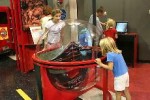Disaster is right around the corner

Natural disasters can be as captivating as they are threatening. A new exhibit at the Museum of Science and Industry called Disasterville provides visitors with a chance to delve into these natural phenomena in an up-close and personal way in the safety of a controlled environment.
Disasterville’s opening on Aug. 5 had been three years in the making, according to Media Relations Coordinator Shani Jefferson. It is also MOSI’s newest permanent exhibit.
Disasterville is an interactive exhibition set up to look like a variety of towns each facing a different natural disaster. Walking through the exhibit, one will find various simulation rooms, each with its own natural disaster inside. The simulation rooms are known in MOSI as immersion theaters because once inside, visitors become immersed in a natural disaster. Visitors can be fully immersed in an earthquake, tornado, hurricane or wildfire.
Each immersion theater boasts a different array of effects. The earthquake room features a moving floor with flickering lights and shaking objects, while the hurricane room blasts visitors with wind and water. Inside the hurricane and tornado rooms, real footage purchased from storm chasers is shown on screens.
Visitors also have the opportunity to participate in other hands-on activities. In this area of Disasterville, there is a hurricane tube, where guests can step inside and feel the impact of a Category 1 hurricane’s winds and a tsunami demonstration. According to Jefferson, a popular feature in this part of the exhibit is a touch lightning simulator, where guests can reach their hands inside a metal display and get up close to lightning.
Perhaps the most educational and interactive part of the Disasterville exhibit is Bay News 9’s WeatherQuest. With help from Bay News 9, MOSI was able to create an interactive news-assignment area that gives guests the chance to participate in or oversee a weather broadcast from a “real” news desk. There is also an authentic meteorologist green screen accompanied by several different computers for relaying messages and putting the broadcast together.
According to Anthonette Carregal, director of academic and family programs, the room holds up to 30 guests at a time and allows them to take on different roles in the “newsroom” and work together.
“Students get to step into different roles in this exhibit, like reporters and emergency management officials,” Carregal said.
While one guest plays the role of the reporter, another guest can step into the role of an emergency management official, and another can play the role of a news anchor. With plenty of roles to act out, guests are able to relay information to one another and put together the news broadcast.
The exhibit is geared toward individuals ranging from fifth-graders to adults, Jefferson said.
“Disasterville was made to be fun and educational, but not too serious, because we have a lot of families and children visiting,” Jefferson said.
The exhibit was created to entertain, and also to put an emphasis on learning and awareness.
The interactive activities and immersion theaters help visitors to understand meteorological and geological science, and some features of the exhibit show visitors how structures can be reinforced and preparation behaviors can be changed to decrease the risk of harm in different natural disasters. The WeatherQuest exhibit would especially benefit anyone with children because the interactive setup helps to develop skills such as teamwork, analysis of problems and analytical thinking.






